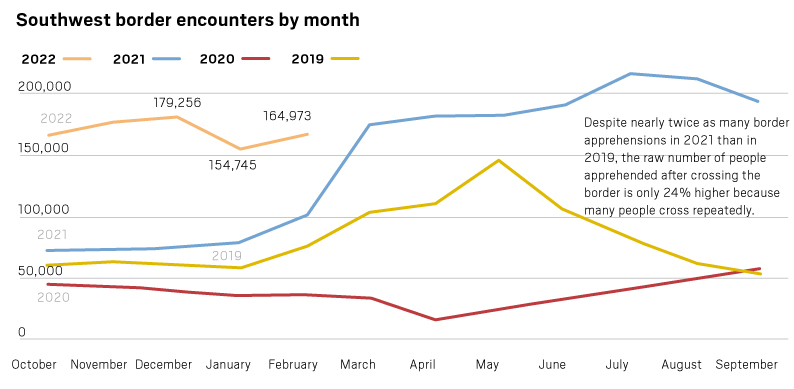
The Centers for Disease Control and Prevention announced that on May 23, its Title 42 public health Order will be terminated. As a result, beginning on May 23, the Department of Homeland Security will no longer process families and single adults for expulsion pursuant to Title 42. Instead, DHS will process them for removal under Title 8.
Title 42 has been in place since March 21, 2020, and was put in place due to COVID-19 cases in Mexico and Canada being seen as a health risk to the U.S. The law intended to help prevent the introduction of COVID-19 into border facilities and into the U.S. People subject to the order are not be held in congregate areas for processing and instead will immediately be expelled to their country of last transit.
Expulsions under Title 42 are not based on immigration status and are tracked separately from immigration enforcement actions, such as apprehension or inadmissibility, that are regularly reported.
Under Title 8, those who attempt to enter the United States without authorization, and who are unable to establish a legal basis to remain in the U.S. (such as a valid asylum claim), are subject to additional long-term consequences beyond removal from the United States, including bars to future immigration benefits.
Ukraine refugees
To protect Ukrainians residing in the U.S., the Secretary of Homeland Security designated Ukraine for Temporary Protected Status for 18 months. This will allow Ukrainians here since March 1, to stay and apply for employment authorization in the U.S.
The U.S. also announced plans to welcome up to 100,000 Ukrainians and others fleeing Russia’s aggression through the full range of legal pathways. In particular, the U.S. is focused on welcoming eligible Ukrainians who have family members in the United States and is committed to protecting the most vulnerable.
Title 42 and border crossings
Title 42 has significantly increased the number of arrests at the border. Under Title 42, individuals who are expelled to Mexico within hours after apprehension can try again a second or third time in hopes of getting through. Some individuals have made dozens of failed attempts to cross the border and been turned back under Title 42 each time. This increase in apprehensions has been seen most among single adults who are not seeking asylum.
Below are the recidivism percentages (percentage of individuals apprehended more than one time by the Border Patrol) for the last few fiscal years:
Since Title 42 went into place, nearly one-third of those have been apprehended more than once.
Estimated outcomes of border apprehensions, October 2020 to August 2021
Under an agreement with the Mexican government in late March 2020, the Border Patrol began sending most Mexican, Guatemalan, Honduran, and Salvadoran families and Haitian asylum-seekers to Mexico. People expelled are usually driven by bus to the nearest port of entry and told to walk back to Mexico.
Those subject to Title 42 who aren’t sent to Mexico are held and flown back to their home countries without any opportunity to seek asylum.
President Joe Biden’s administration expelled by plane more than 7,000 Haitians who had sought asylum in September 2021.Roughly 10% of people encountered after crossing the border are unaccompanied children who are sent to federal shelters.
Sources: U.S. Customs and Border Protection, American Immigration Council
